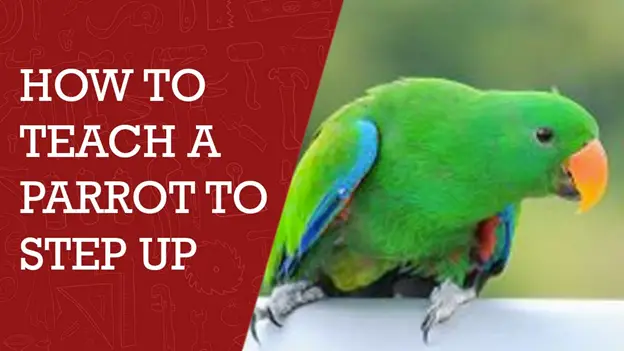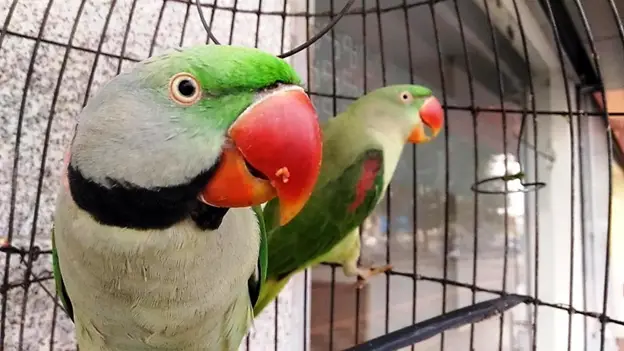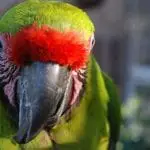Usually, most birds love their time when they are out of their cage. We notice this because most pet birds are hard to get back in their cage after they do some outdoor activities. You may easily get back your pet into its cage by doing some training in your pet. However, before introducing caging to your new bird, it would be a great idea to teach him how to step up first and pick and to hold him the right way so he will follow your instructions for caging easily.
In this post, you’ll learn some helpful tips on how you may easily get your bird back to its cage. Let’s get started!
How to Teach Your Parrot to Step Up
The right way to pick up your parrot is to offer your arm or hand while saying, “Step up.” This action should always be rewarding and always exciting for the bird. Always reserve his favorite games or treats during the times your bird steps up for you. Don’t force him to step up onto your arm. You can havoc a good relationship if you insist on your parrot to do something that he does not want to do.

Here’s how to train your parrot to step up:
1. Use a Washcloth or Towel
As previously mentioned, some birds are afraid of human hands, so if that’s the case with your parrot, go ahead and teach him to step up on a washcloth or a towel. Just use lots of positive support, such as a play or some treats, to help him relate positive things with stepping up.
2. Proper Timing
It’s hard to get a pet to step up from your shoulder if he does not want to. Your parrot can move around to your back, wherein you cannot reach him. The general rule of thumb for a bird owner is that only those birds who immediately step up must be allowed on your shoulder. In this way, you’re showing your pet how to earn shoulder privileges.
3. Avoid Wearing Jewelry
Another caution around letting your bird pet perch on the shoulder is that parrots generally love shiny or bright things. If you are wearing jewelry, your parrot may try and play with them. It can result in damaged jewelry. Of course, you don’t want your earrings to get damaged too, or being forcibly removed that can hurt your ears. It is important to know your bird, and only wear a piece of jewelry if you know that he is not interested in forcibly grabbing it.
4. Start from Scratch
If ever you adopt a pet parrot that doesn’t understand your “step-up” instruction or one that has never been handled, it means that you need to start from scratch. By doing so, you’ll help your pet parrot learn how to follow your cues. You also want your bird to learn it is rewarding and pleasurable to step up. If you want this behavior for your bird, teach him outside of the cage.
How to Know If a Parrot Is Ready to Be Picked
How would you know if the parrot wants to be picked up? Vocalizations only make a small percentage of communication among parrots with other birds of the same flock, and the rest of that communication is done through body language.
The first reaction of a bird who senses an unwanted approach is to bend his body. Your parrot tries to avoid and tighten his feathers close to his body. Your parrot might use his head or beak to push the object away, or your pet might raise one-foot to show resistance.

Here are a few reminders:
- Always bear in mind that a parrot who wants to be picked will most likely lift his foot. It’s completely up to you to assess the body language of your pet to know what he is trying to tell you.
- If you neglect signs that your attentions are unwanted, it can lead to increased agitation in the bird. Body language like rapid contraction and dilation of the pupils, an open beak, flared tail feathers, and erect crown feathers can be indicators that your bird is anxious or scared— so you should keep your distance.
- By respecting your bird’s nonverbal cue for “No, thanks” may actually push him to respond and bite to make his point.
- Let your bird make choices for a stronger pet-owner relationship. It is also best to reward desired or positive behaviors with positive reinforcement, such as treats, play, or praise.
Introducing Cage to Your Parrot
A cage is considered a bird’s home or sanctuary. If you feel that your parrot doesn’t trust at this time, don’t insert your hand into the cage because you’ll just violate his personal space. Let your parrot hang out on top of his cage. Simply placing your arm on the birdcage top in front of the bird is a good idea. Do not move your arm and just let him lie there. You do it a couple of times until your parrot is familiar and accustomed to your arm in his space.
Next, you can offer his very favorite treats with your other hand, requiring your parrot to lean towards your arm. The treat should be gradually given a distance away until you’ll be able to force your bird to step up on your arm in order to retrieve it. Give your pet parrot lots of treats and praise for doing this.
Practicing this lesson numerous times before you add the cue “step up” is a good idea. When your parrot totally comfortable standing on your arm, then you can raise it a few inches. Just continue with this good exercise until he’s stepping up on cue.
Here’s how to encourage your bird to get back in its cage:
- Every time that you are in a rush to maybe get into your work or any other things that you might do, you may observe that it seems that it’s the time that your pet is trying to play with you, especially when you try to put them up in its cage.
- As you feel panic, your pet bird may also feel the same as yours. So keep in mind that the birds belong to flock animals. It tends to be attentive, especially with the human’s body language. When it comes to birds, a flock portion that cats like upset and it moves so inconsistent might be a probability of mortal risk.
- Try to take it in a slow way, speak to your pet softly, and behave as if you have all the time to pick them up back to their cage. It is good to just whisper to a screaming type of parrot to easily differentiate its behavior, but this totally works. It is just easy like you need to change your behavior first in order to change your pet bird’s behavior.
Conclusion
When teaching a bird, like a parrot to get back in its cage, you have first to teach him how to step up and pick him at the right time. It’s not a good idea to introduce caging early. Make sure to make every step as smooth and as natural as possible for the bird to follow your commands.


